Ford Ranger pickup review (2024)
Read our expert review of the Ford Ranger pickup truck
PROS
- Stronger and more capable than ever before
- Refined and composed to drive
- Excellent interior space
- Brilliant off-road performance
- Loads of versions to choose from
CONS
- Very similar to rival VW Amarok
- Infotainment screen sometimes fiddly
- No hybrid or electric variants yet
- 2.0-litre engines aren’t the most refined
- High-end versions get expensive
Summary
The Ford Ranger has always been one of the very best pickup trucks, and this latest version continues a proud tradition of being one of the .
The all-new 2024 version is not simply a development of what went before, though. For the first time, the Ranger is a result of Ford's partnership with Volkswagen, so it shares vast amounts with the new Volkswagen Amarok. Some might say that they are the same truck, but there are significant cosmetic differences. The result, however, is a pair of pickups that leave the rest of the market in their wake.
While VW was able to make substantial alterations to the look and cabin, the fundamentals of this pickup are all Ford's. That means elements such as the engines and gearboxes are all ones that will be familiar to anyone who has spent time in the Transit and Transit Custom et al in recent times. The infotainment system and many of the other elements are Ford’s too.
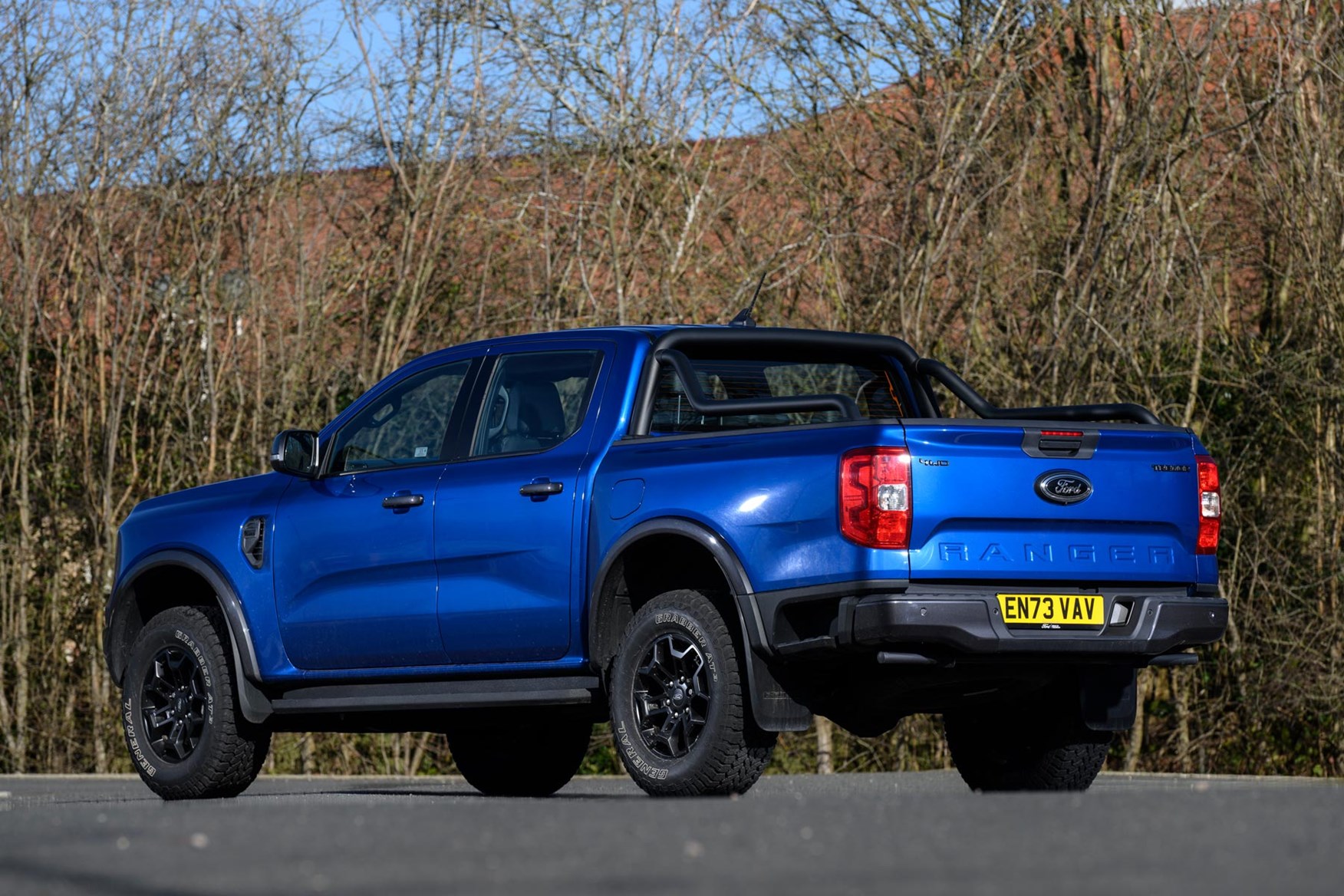
What engines and trims does the Ford Ranger come with?
The Ranger comes with some familiar engines – the 2.0-litre diesel that is available with 170hp or 205hp is certainly one that has featured in the past. The 240hp 3.0-litre V6 diesel is new for 2023 onwards, however.
There is a wide range of trims on offer: XL, XLT, Tremor, Wildtrak, Wildtrak X, Platinum and the sporty MS-RT. Then there’s the even more outlandish Ford Ranger Raptor, which takes the total to eight.
Verdict: is the Ford Ranger any good?
In short, yes. Ford's taken a great pickup truck and made it even better. If we’re going to get picky then it’s a shame that the Ranger is now so similar to the Amarok, but the Ford is the better of the two. The difference is one dictated by fine margins and it's largely down to the payloads on offer in the top trims. We’d also like to see something other than the ubiquitous diesel engines, but why break a format that works for now. Keep reading for our full, in-depth verdict.
Skip to our full verdict on...
- Remarkably refined for a pickup
- Strong engines
- Excellent off road
Modern pickup trucks are more likely to be bought by someone wanting to spend the majority of their time on road, rather than those needing a hardy tool. This, unsurprisingly therefore, is where the Ford Ranger excels.
It takes its refinement and quietness up to a new level, with the 3.0-litre diesel particularly relaxed in almost all on-road scenarios.
A 10-speed automatic gearbox is offered as standard in every version from Tremor upwards, with only the XL and XLT getting the six-speed manual. The auto is one of the best examples of Ford’s self-shifting ‘box we’ve used. It suits the Ranger’s relaxed on-road nature, and it is best to leave it to just do its thing the majority of the time. You can shift gears yourself, but it requires you to use a fiddly little switch on the side of the shifter and the 10 ratios is too many to pick from, so you are best off leaving it alone.
The manual, however, feels much more basic in its application. You need a big slug of accelerator to get everything moving smoothly and it requires a very definite action to shift gears on the move. It works, but it feels much more old-school than the auto.
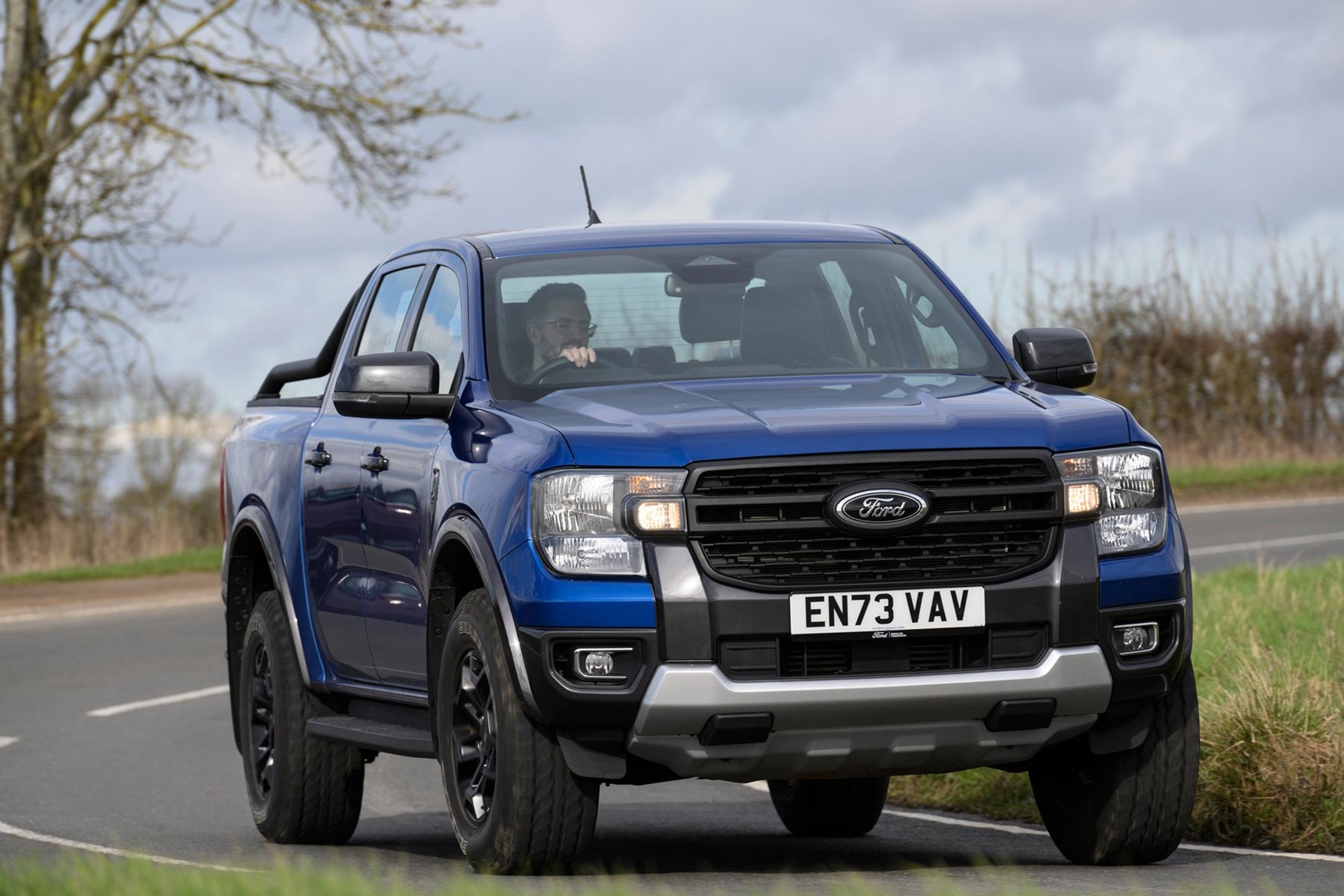
All the sophistication of the automatic gearbox has to be viewed from a pickup context, though. While it might bridge the gab between SUV and truck, the Ranger is still firmly a commercial vehicle, and firm is the key word there.
The ride is still on the agricultural side of things, as the Ranger has to be tough enough to cope with carrying over 1,000kg in the loading bay, which requires some strong rear suspension. As a result bigger bumps make their presence known at all speeds, while smaller imperfections jolt you around when you slow things down. The rear wheels come off an urban speed bump with a rather definite thump, even when the loading bay is empty, but it feels solid rather than overly harsh.
That said, the Ranger is the pick of the pickup class when it comes to on-road behaviour. At the mid-range speeds that most non-urban based users will spend the majority of their time, it copes well with the regular imperfections on UK roads. It is superior to its direct equivalent, the VW Amarok, too. This is aided by the fact that the largest standard-fit alloy wheels you get on a top-spec Ranger are just 18-inches, which is much more appropriate than the 21-inch rims that you can get on rivals that put visuals over practicality.
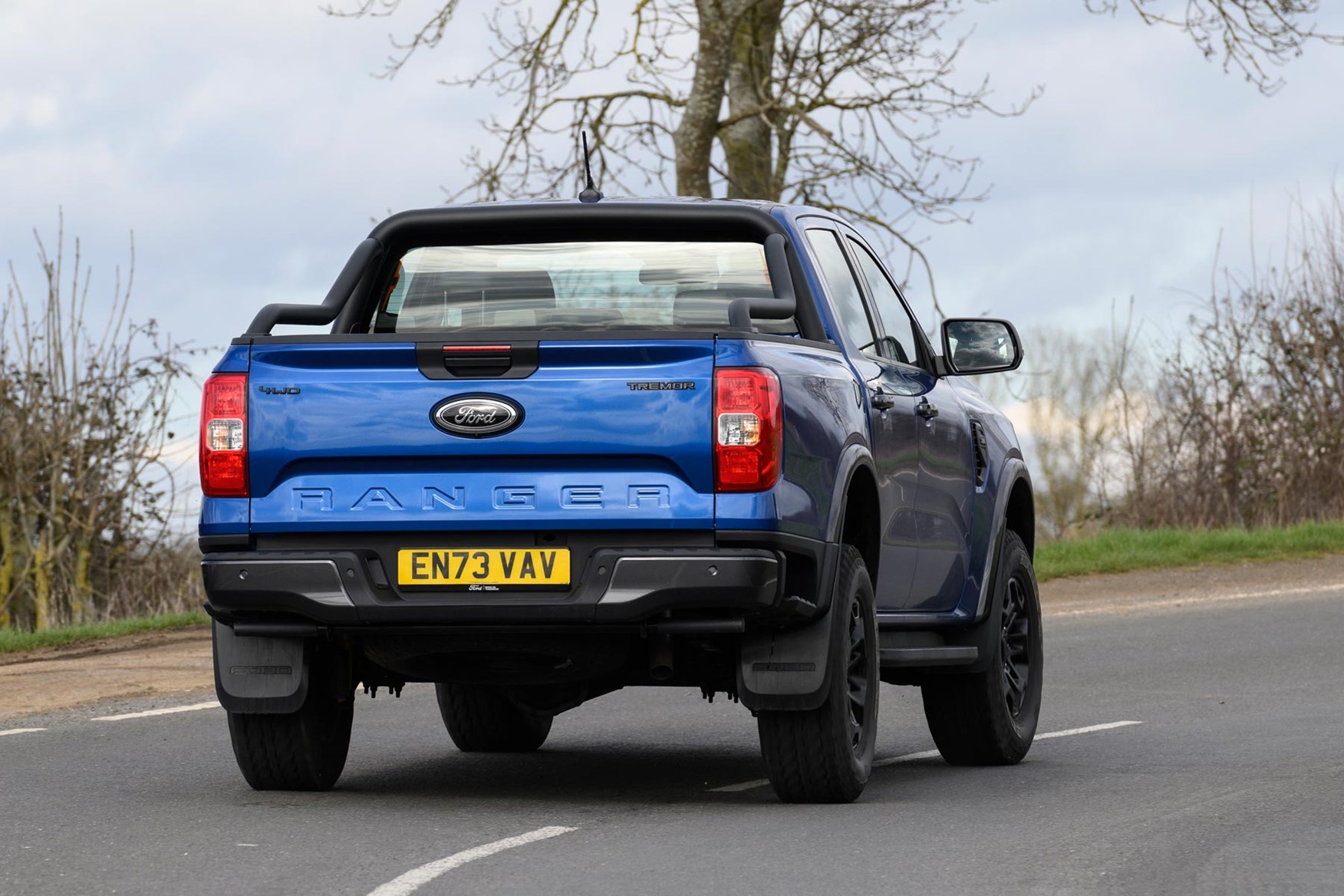
The steering is light for such a big truck, too, meaning that your progress around town is more likely to be impeded by the Ranger’s size. Although it isn’t large compared to the likes of the Ford F150 that is such a common sight in America, this is still a big vehicle by UK standards.
This brings benefits in other ways, though, as you get a fantastic view out of the front and around all angles. If this isn’t enough, then every version bar the single-cab in the most basic trim comes with some form of camera. The majority of versions come with a rear-facing camera, which is enough to deal with most parking manoeuvres, while the Platinum has a 360-degree view.
One real oddity is that you only get stop-start technology from the high-up Wildtrak X trim. If you are going to be spending lots of time around town, using your pickup as an all-purpose working and family vehicle, then this doesn't sit right. It might be a small thing, but given the increased focus on urban pollution, surely this should be standard across the range.
What is the Ford Ranger like off road?
Our off-road experience with the Ranger has been relatively limited so far, but where we have ventured off tarmac it has excelled, and this is in proper mud-plugging terrain. This is down to a variety of factors, including the ease with which you can switch between different modes and driving setups.
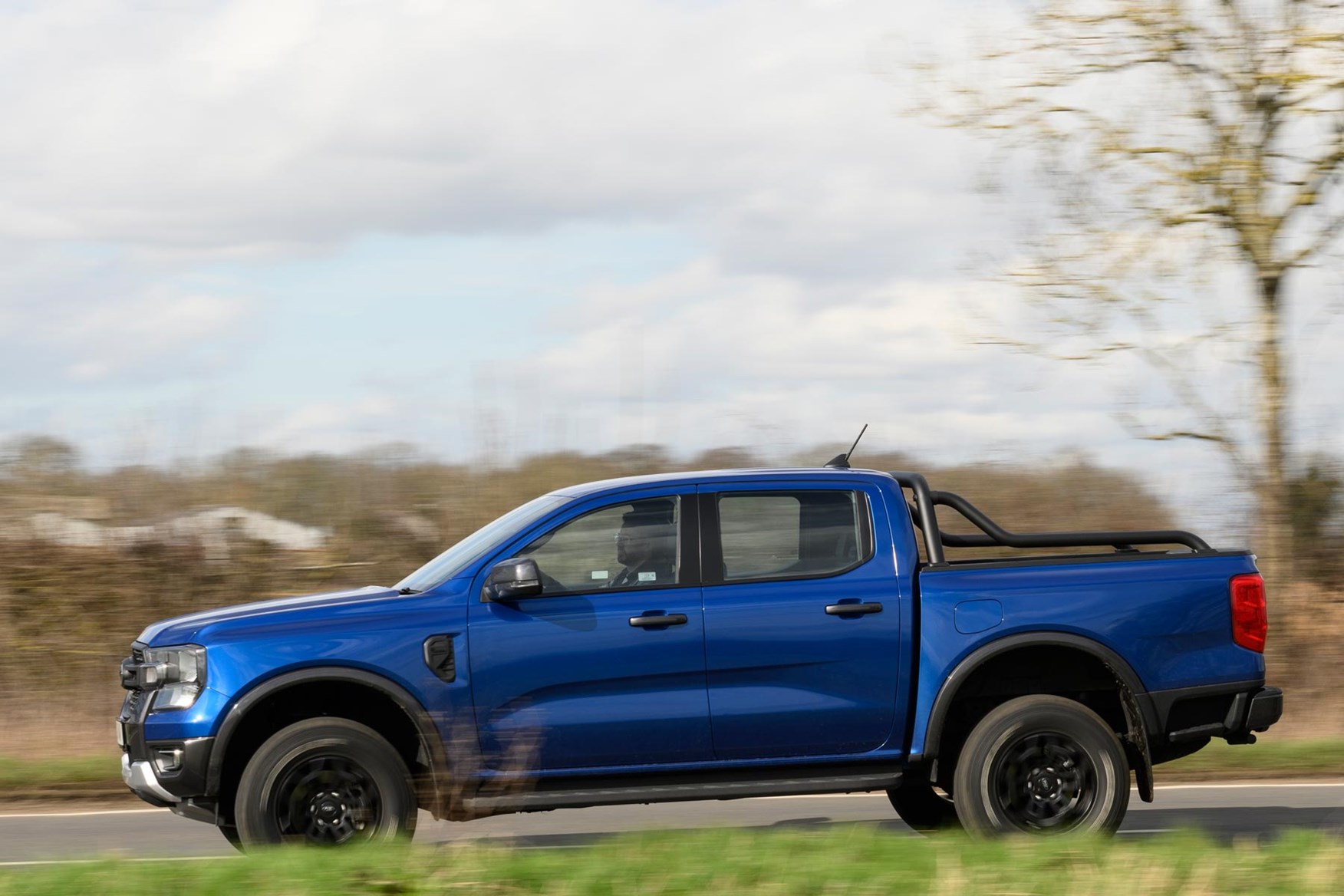
There’s a wheel behind the gear lever, which you can spin to switch between settings such as 2WD, 4WD and low-ratio gearing. If you want a bit more tweakery then it will also allow you to switch between various modes, with different setups for different terrains.
The Tremor would be our pick if you are planning on off-roading on a regular basis, though – it comes with extra underbody protection and bespoke off-road suspension. Nothing that it comes with impacts how it handles on the road, though, so it remains a great all rounder. Other versions are also offered with extra off-roading kit, but the Tremor's carpet-free floors is a real bonus too, and it has a rugged charm.
- Smart and clear interior
- Excellent central screen
- More space than previous version
The low level of engine noise that makes its way into the Ranger’s cabin is really impressive, which will be of particular interest to those mulling over the idea of running a pickup as their only vehicle. The higher powered 205hp 2.0-litre diesel is marginally less refined when you put your foot down heavily but it will cruise happily the majority of the time. There’s also pleasingly little wind noise, although the large tyres mean that you do get to hear the wheels on the road.
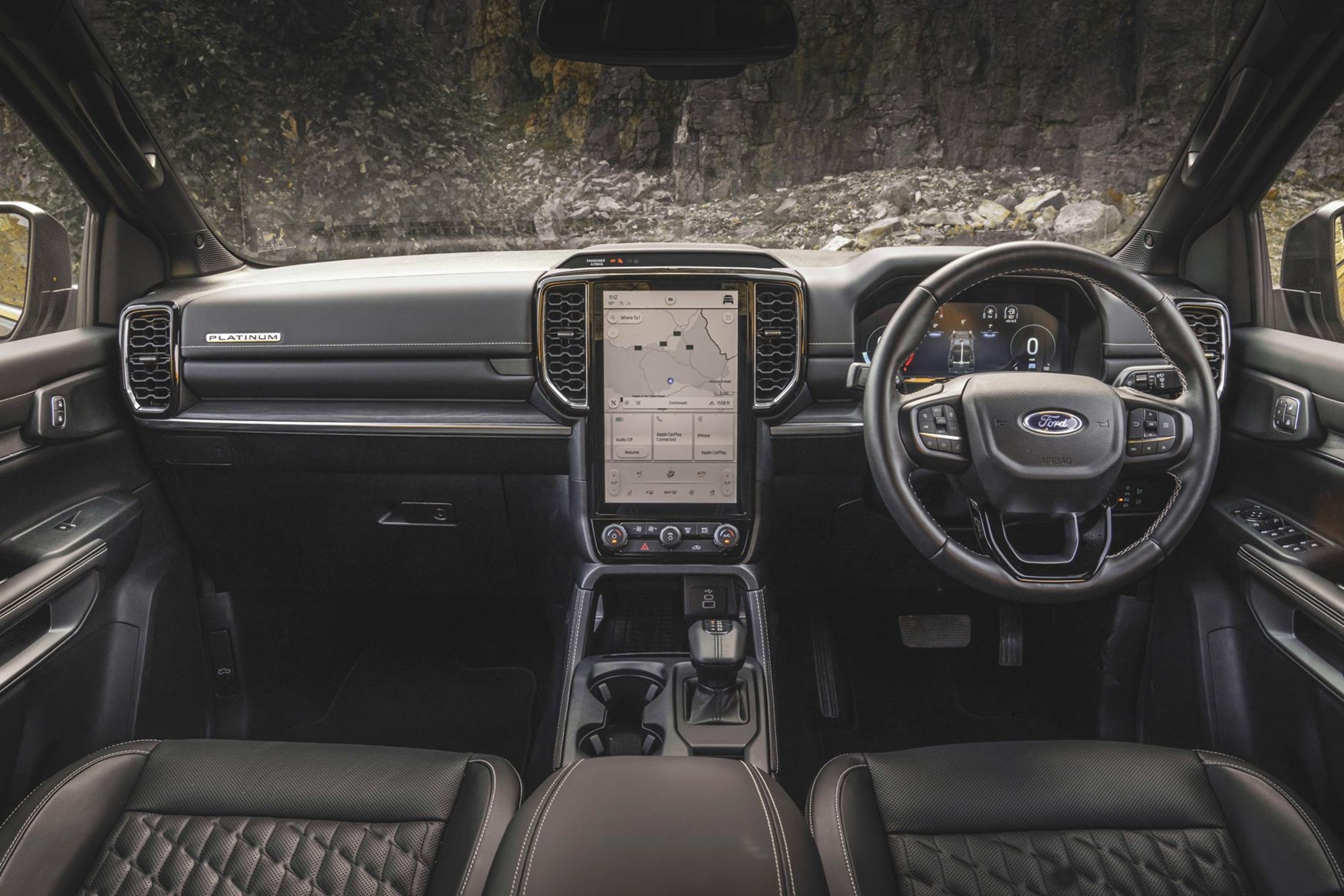
The cabin has taken a big step up from the previous version of the Ranger, both in terms of space and fit and finish. On the higher end trims we have spent time in so far, the materials really do feel excellent. The Wildtrak might now be a mid-range model, but it still boasts plenty of leather on the elements you touch regularly. The Platinum takes this up several more notches, with the wonderfully plush leather seats among the many highlights.
There’s more space, too, with the electronic parking brake freeing up plenty of room in the central console, so you get a good-sized slot for your phone up front, a couple of cup holders and a good, lidded box.
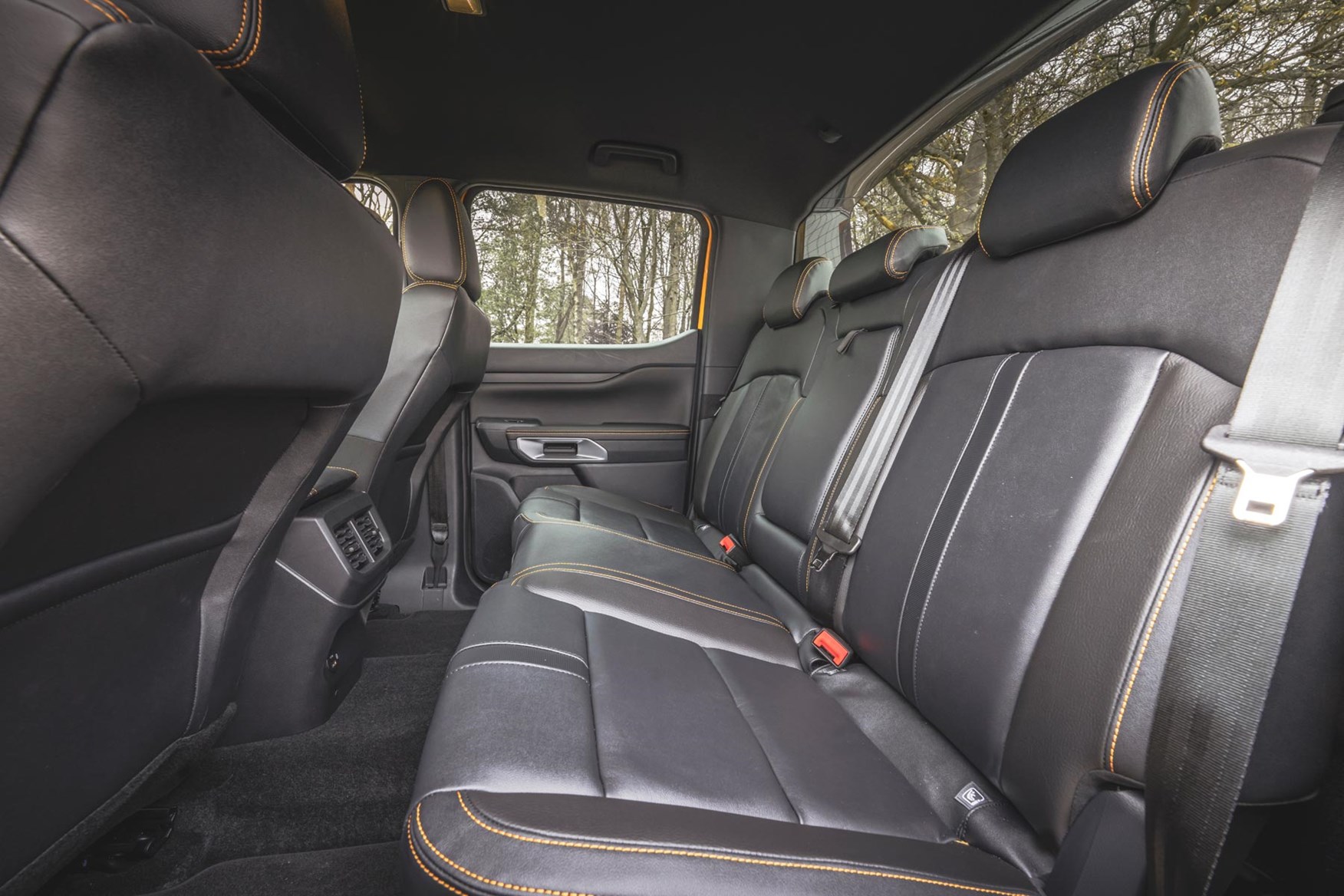
A longer wheelbase and a redesign of the back of the cabin means a touch more legroom for rear passengers than in previous generations. It’s still not as comfy as an SUV, though, as the starkly vertical bulkhead behind the rear seats means that you sit upright. This also makes it a little trickier to get some child seats in, should you want to use your work truck as family transport at the weekend. It should be possible, but it would be worth checking if your seat is one that is on the large side or if it is one that has a steeply slanted rear.
Not all versions come with carpets and leather aplenty, though - the Tremor feels wonderfully kitted out for a trip to a muddy field. Not only does it come with wipe clean floors, it has less in the way of leather detailing around the cabin. It's a workhorse, but it still has some of the kit and charm that makes the Ranger feel like a true all rounder.
Ford Ranger infotainment
The central screen is one area where the Ranger shines. The portrait-style, vertically orientated display is large and clear and easily navigated with shortcuts to get you back to the home screen. Not every version gets the same screen, however, with the lower-end models getting a 10-inch version while Wildtrak and above getting a 12-inch model. The larger one has enough space to show more than one thing at a time – you can have navigation up top and a selection of shortcuts down below, to easily switch to the radio, for example.
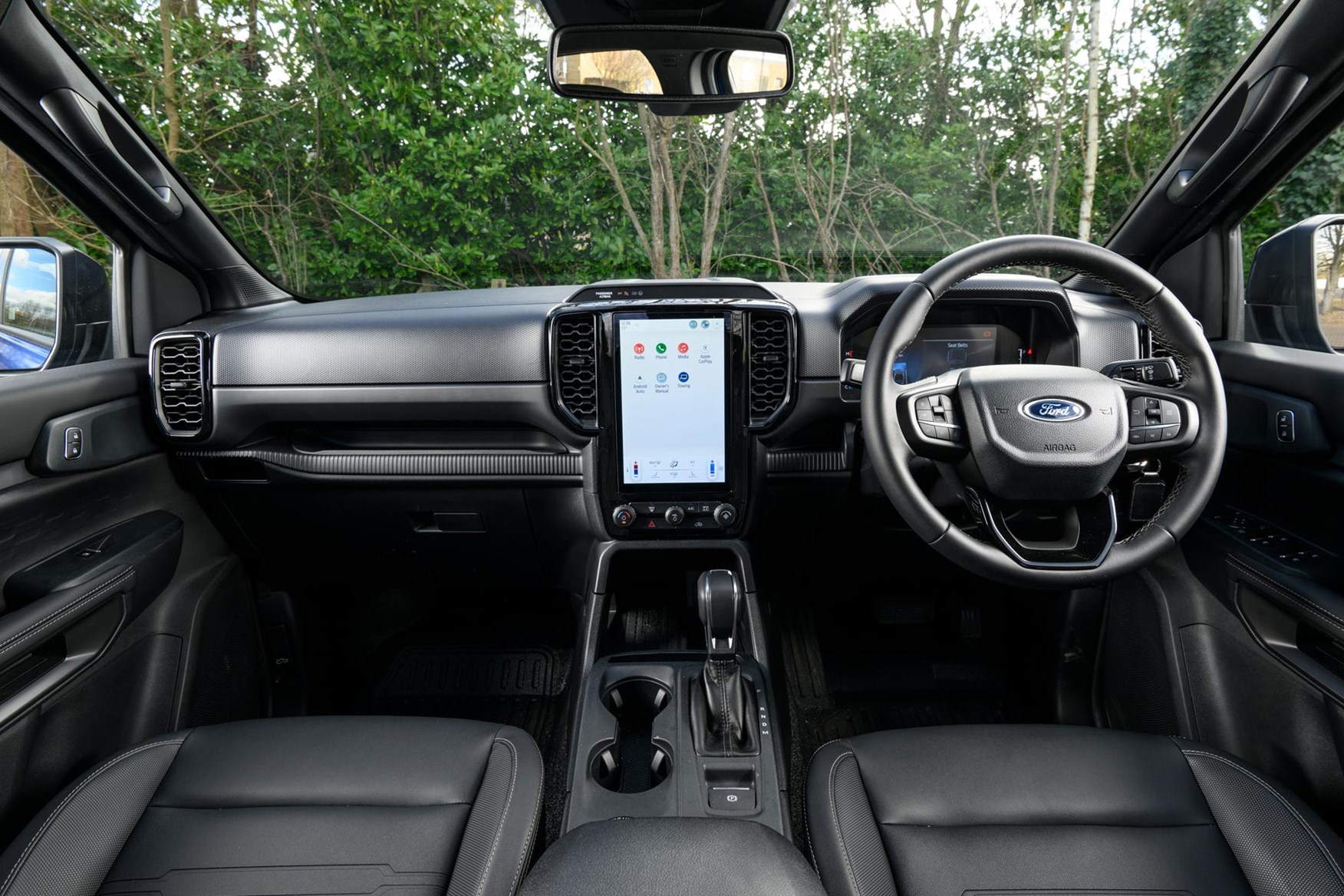
Mercifully, there are several physical buttons below, too, so you can swiftly tweak the cabin temperature and fan speed, without taking your gloves off.
The digital display in front of the steering wheel is clear, too, and gives several options for what you can have on show. Arguably there might even be too many, and some might prefer it to just give you the basic information, but there should be a layout for most tastes.
- Wide range of different models
- All standard models qualify for van tax rates
- Fuel economy about par for a big truck
Buying and running a big truck is in some senses not the cheapest option available, but the standard Ranger does at least qualify for the various commercial vehicle tax rates that make costs much more appealing. The Ford Ranger Raptor doesn't, though, but describing that as 'standard' would be stretching the definition somewhat.
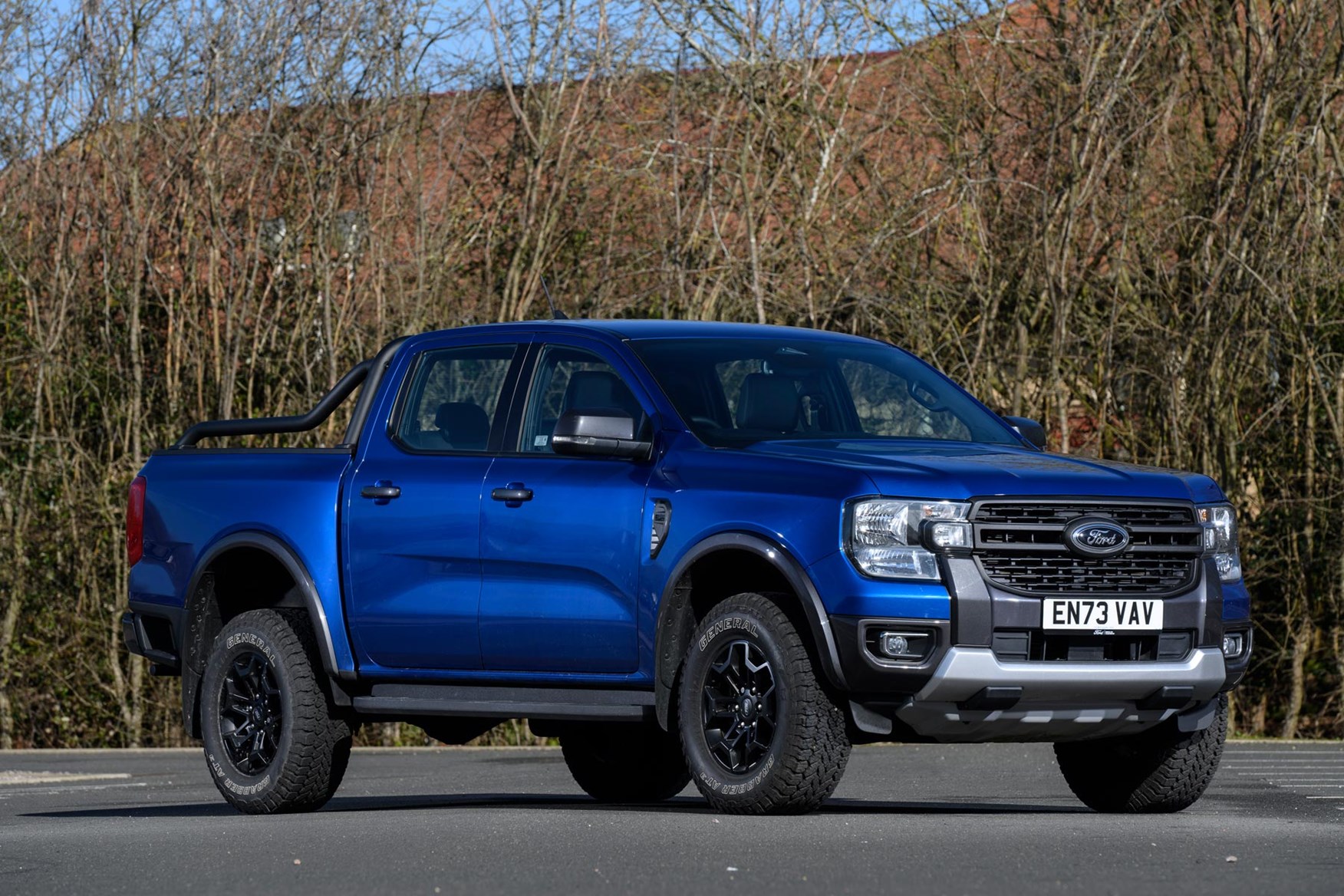
Every version of the standard Ranger offers a payload in excess of 1,000kg, which means business customers can reclaim the VAT and qualify for commercial BIK and VED rates (read more on that in our dedicated van tax guide). This might not seem a big deal, given almost every pickup truck manages this, but it is notable as the top trim versions of the VW Amarok don’t hit this mark, nor does the most extreme version of the Ranger, the Raptor.
Ford Ranger mpg
A big, blunt-shaped truck is never going to be the most economical vehicle, so the best we can say is that the Ranger is at least par for the class. It averages between 27.2mpg for the 3.0-litre V6 in Wildtrak X trim up to 33.6mpg for the XLT with the 170hp 2.0-litre diesel with the manual gearbox. These are all official WLTP figures, though, so might not be achievable if you spend a lot of time lugging around the maximum payload.
Our real-world experience shows that the quoted economy is a realistic aim, although we didn't spend all our time tootling around with a full load bay to be fair.
Ford Ranger standard equipment
There are seven standard trims of Ford Ranger, meaning that there really should be a version for everyone. We treat the Ranger Raptor as a separate entity, so the standard models are the XL, XLT, Tremor, Wildtrak, Wildtrak X, Platinum and MS-RT, with the various highlights detailed below.
Ford Ranger XL standard equipment highlights:
- Black bumpers and door mirrors
- Auto lights
- Rear-view camera (double cab only)
- Four electric windows
- Power plug in the rear (double cab only)
- Reverse park assist system
- Wiring for trailer towing
- 16-inch steel wheels with full-size spare
- 10.0-inch infotainment screen
Ford Ranger XLT standard equipment highlights (in addition to XL):
- Body coloured bumpers and mirrors
- 16-inch alloy wheels with all-season tyres
- Standard duty terrain pack with selectable drive modes
- Auto wipers
- Fast defrosting windscreen
- Leather gear knob and vinyl steering wheel
- Tyre pressure sensors
Ford Ranger Tremor standard equipment highlights (in addition to XLT):
- 17-inch alloy wheels with full-size alloy spare
- Extended wheelarches
- Heavy duty side step
- Under body protection
- Roll bar in loading bay
- Black headlining in cabin
- Loading bay light
- Leather covered steering wheel
- Off-road suspension
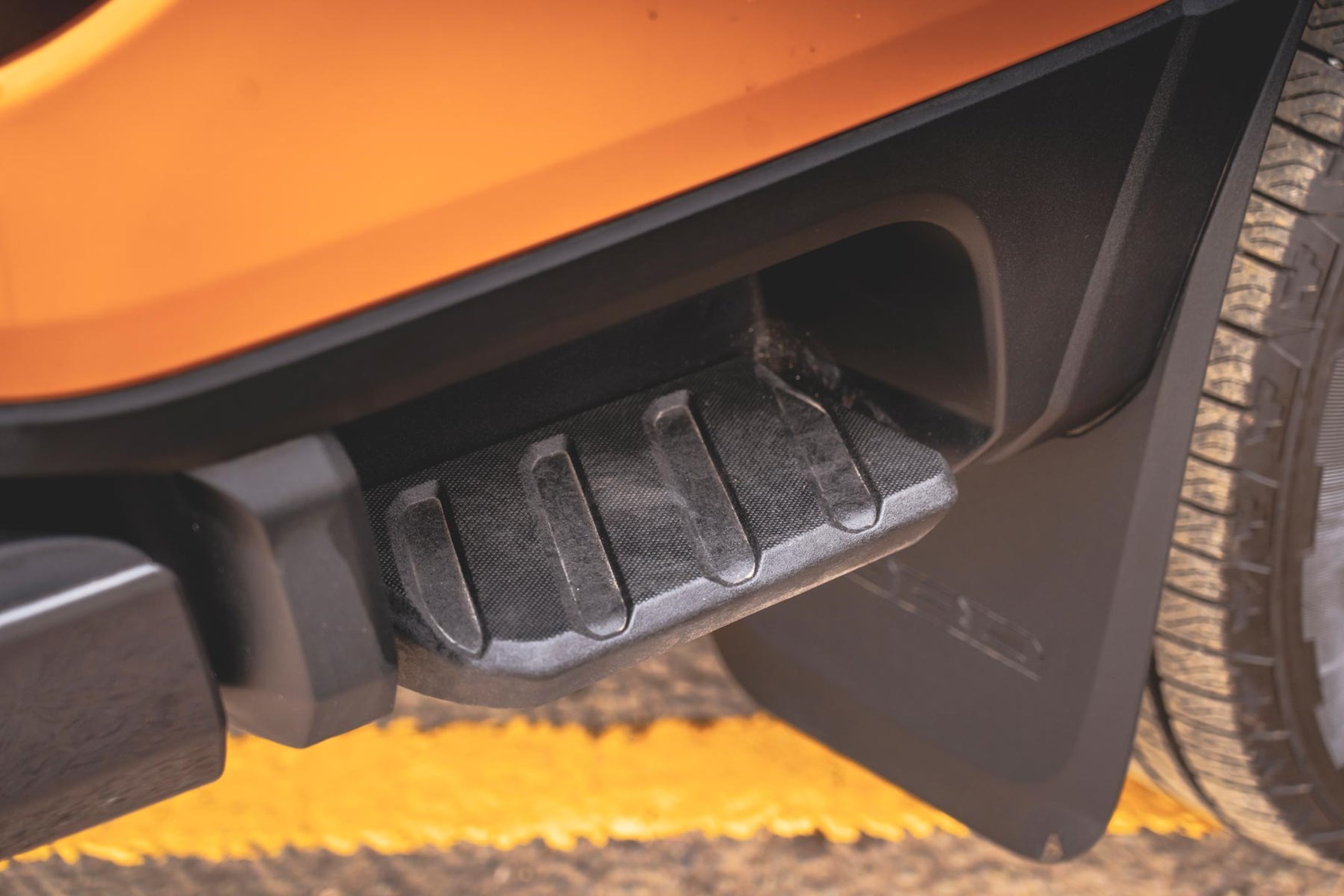
Ford Ranger Wildtrak standard equipment highlights (in addition to Tremor):
- 18-inch alloy wheels with full-size aluminium spare
- Roof rails
- Cab rollover bar
- Active grille shutter (3.0-litre diesel only)
- Privacy glass
- Locking glove box
- 12.0-inch infotainment screen
- Heated front seats
- Heated steering wheel
- 12V socket in the rear
- Premium floor mats
- Soft-ride suspension
- Electric handbrake
- Keyless entry and start
Ford Ranger Wildtrak X standard equipment (in addition to Wildtrak)
- 17-inch alloy wheels with all-terrain tyres and full-size aluminium spare
- Off-road suspension
- Honeycomb front grille
- Heavy duty side-step
- Stop-start system
Ford Ranger Platinum standard equipment (in addition to Wildtrak X)
- 18-inch alloy wheels with full-size alloy spare
- Wireless phone charging
- Front parking sensors
- 360-degree camera
- Powered, heated and cooled front seats
- Soft-close tailgate
Ford Ranger MS-RT standard equipment
- Sports style front and rear bumper
- Extended wheel arches
- Side skirt
- Cab and rear tailgate spoilers
- MS-RT seats front and rear
- MS-RT stitched leather steering wheel
- 21-inch alloy wheels
The options and accessories list contains a selection of handy features, with plenty to kit the loading bay out to your precise needs. The best of the lot is the powered roller cover for the loading bay, which allows you to open and close the rear from the cabin, in the loading bay or via a button on the key.
This is a brand new pickup so there is no historical data on this particular version. However, the engines and gearboxes are shared with many thousands of other Ford vehicles, commercial and otherwise, which means they are well tried and tested and have historically had problems with injectors and wet belt recalls. The injector issue only affected engines built between certain dates in 2019, though, so is not an ongoing one.
- Good level of standard kit
- Plenty of airbags
- Intelligent driving features available from mid-level trim
Despite being a commercial vehicle, the Ford Ranger is unlike most panel vans in that every version gets a decent level of standard safety and security equipment.
Every model gets the following included as standard:
- Driver, passenger, side and curtain airbags
- Belt warnings all round
- Lane keeping assist
- Adaptive speed control
- Reverse parking aid
- ABS and ESP
- Speed sign recognition
- Alarm
- Locking tailgate
Then when you get to Wildtrak, the following gets added, but only on the 3.0-litre V6 diesel versions:
- Lane change warning and aid
- Intelligent speed assist
- Blind spot detection
- Reverse braking assist
Which Ford Ranger is best for me?
With so many trims to choose from, picking which Ranger to go for could seem intimidating. We’re fond of the Tremor because of increased off-road capability and charmingly rugged interior. However, the Wildtrak is also a compelling prospect due to its extra all-terrain gear.

The super luxury Platinum trim comes with even more kit and is a real high-end truck. It has more in its favour than rival high-end versions from VW, too, as it still offers the 1,000kg-plus payload.
If you have the choice, then the 3.0-litre diesel engine promises more accessible power and a more relaxed experience, but that isn’t to put down the 2.0-litre, which will be still more than capable in everyday situations. In short, there is every chance that there will be a version to suit your needs.






















